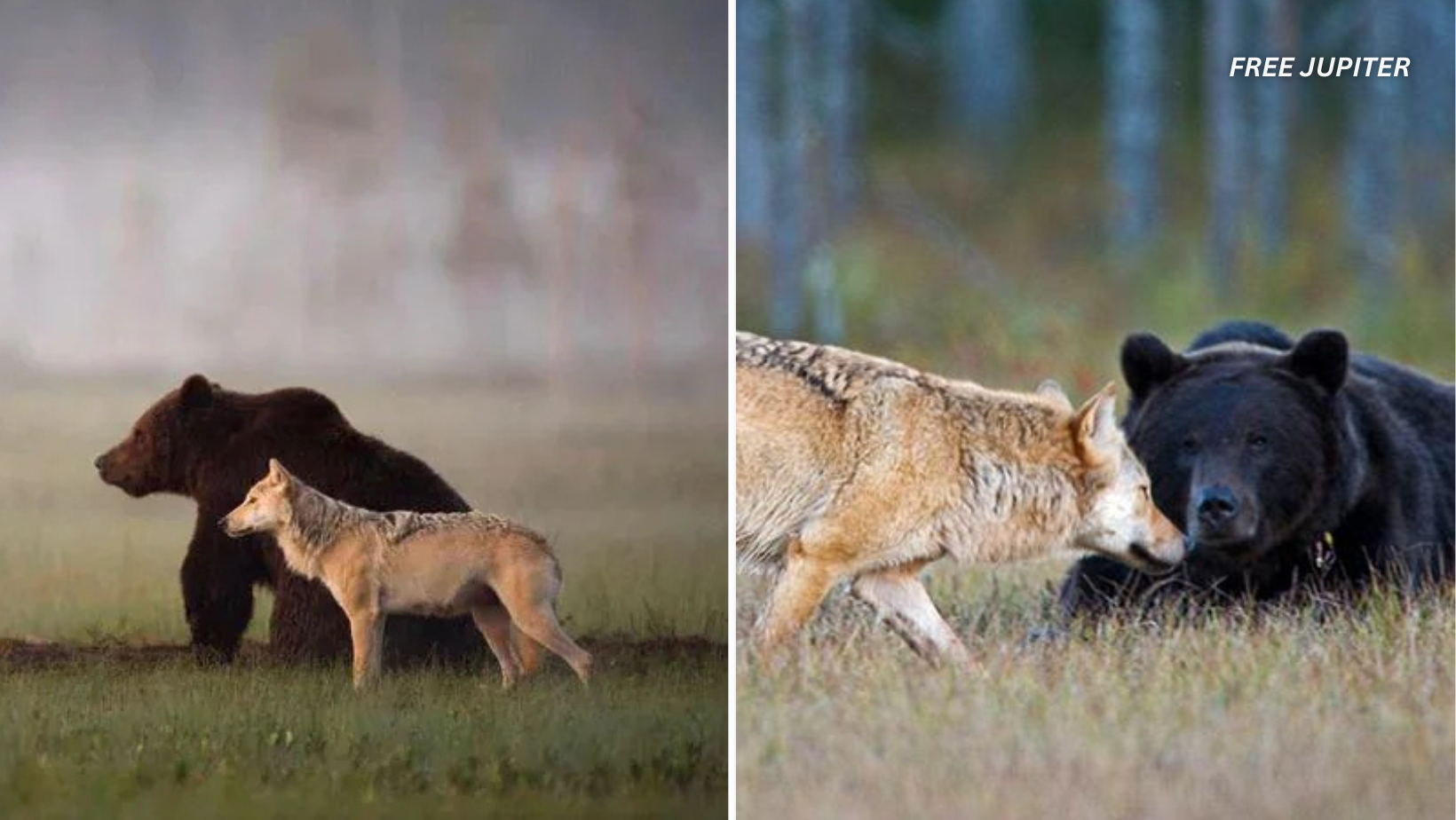Friendly Note: FreeJupiter.com shares general info for curious minds 🌟 Please fact-check all claims—and always check health matters with a professional 💙
Nature never stops surprising us. In an astonishing event that defies most scientific assumptions about animal behavior, a wild wolf and a brown bear were recorded traveling and hunting together over several days. The footage, taken in Finland’s boreal forest, quickly became a global sensation. While predators usually compete for territory and prey, these two forged an unlikely partnership. Wildlife researchers and ecologists were stunned and curious. Why would two apex predators, typically at odds in the wild, choose cooperation over conflict?
Finland’s Remote Wilderness
The sighting took place in the dense northern forests of Finland, where wolves and bears coexist but rarely interact in positive ways. The area is a haven for wildlife photographers due to its natural abundance and minimal human interference. With hidden cameras set up to capture wolves in their natural behavior, researchers expected typical solitary movement or wolf-pack dynamics. Instead, what they found was an extraordinary bond that challenged conventional predator-prey relationships. The region is also known for large populations of moose, deer, and elk, making it a common ground for predators who rely on large mammals for sustenance during the hunting season.
Read More: Recordings Showing Orcas Mimicking Human Speech is Freaking Listeners Out
Footage Reveals an Unlikely Pair
Photographer Lassi Rautiainen, who documented the event over ten days, said it was one of the most baffling encounters he had ever seen. The wolf, a young gray female, and the bear, a burly male brown bear, appeared to develop a mutual understanding. The two were seen walking side by side, resting near one another, and more astonishingly, sharing food after a successful hunting expedition. In several frames, the wolf even appeared to act as a lookout while the bear ate, then took its own share once the bear moved on. This sharing behavior is almost unheard of in the wild, especially between different species of predators.
Challenging Scientific Assumptions
Traditionally, apex predators are known to avoid each other or engage in hostile competition. Bears are known to drive wolves off carcasses, while wolves often harass bears to dominate hunting territory. So what made this case so different? Wildlife biologists speculate that the pair may have formed a temporary alliance based on mutual benefit. The bear, with its brute strength, could overpower large prey or scavenge from kills. The wolf, agile and fast, could track and chase animals through difficult terrain. By teaming up, they increased their hunting efficiency, especially in a competitive ecosystem with limited food.
Possible Reasons Behind the Unusual Behavior
Several theories have been proposed to explain this behavior. One idea is that both animals were relatively young and lacked strong connections to their own kind. Without a wolf pack or bear mate, they may have sought out companionship in one another. Another theory suggests a shared hunting strategy evolved from repeated encounters. After stumbling upon the same carcass or location several times, they may have started recognizing each other as useful allies rather than threats. A third possibility is environmental pressure. If food scarcity were a factor, cooperation might have become a survival strategy rather than a choice.
Do Wolves and Bears Have a History of Cooperation?
Although this kind of friendship is scarce, there are isolated reports that hint it may not be entirely unprecedented. In some wilderness areas, scavengers, including wolves, bears, and even ravens, can be seen feeding from the same kill, often tolerating one another briefly. However, true collaboration and shared hunting efforts have not been documented with the same clarity as in the Finnish case. Researchers stress that while this event is remarkable, it may be a one-time occurrence and not representative of general wolf-bear interactions across the globe.
Experts Weigh In on the Encounter
Dr. Ilpo Kojola, a large carnivore specialist with the Natural Resources Institute Finland, noted that while bears and wolves share overlapping territories, there is little documentation of friendly interaction. He emphasized that the images and video footage could shift how scientists interpret interspecies dynamics in carnivores. Behavioral ecologists are now considering the possibility that animals, under certain circumstances, may display far more flexible behavior than previously understood. Dr. Kojola also pointed out that this kind of alliance could open new lines of research into how predator communities function when food becomes limited or when typical social structures are absent.
Read More: Scientists Say Dogs Are Entering In a New Stage of Evolution
A Glimpse Into Animal Intelligence and Emotion?
Some animal behaviorists have suggested that this case might even point toward deeper emotional capacities in wild animals. The wolf and bear appeared relaxed in each other’s presence. They often rested together and displayed no signs of fear or aggression. Could this be a glimpse into an emotional alliance, perhaps even friendship? While attributing human emotions to animals is controversial, many scientists acknowledge that mammals like wolves and bears have complex social behaviors. In fact, wolves are known for tight family bonds, and bears, though more solitary, show attachment to cubs and sometimes even adopt orphans. The interaction hints at a form of trust that goes beyond simple hunting strategies.
The Role of Cameras and Modern Technology
This entire discovery would likely have gone unnoticed without modern wildlife photography and motion-triggered cameras. These tools allow researchers to observe animals in their natural habitat without interference. With more areas being monitored through long-range lenses and hidden video setups, there is increasing potential for discoveries like this one. In this case, the camera lens became a window into behavior that defies the rulebook. The wolf and bear pairing might inspire more focused studies using camera traps to look for similar events elsewhere in the world. In fact, it may change how scientists set up hunting observation stations and what behaviors they prioritize.
Public Reaction: Wonder and Curiosity
The images quickly went viral online, sparking conversations across social media and news platforms. Many people found the story heartwarming and hopeful, suggesting it symbolized peaceful coexistence in a fractured world. Some viewed the footage as a metaphor for unlikely friendships, while others were simply amazed at nature’s unpredictability. Animal lovers praised the peaceful dynamic, and wildlife photographers began revisiting old footage to see if they had missed other examples of cooperative hunting or interspecies relationships. The story has even inspired documentaries, educational videos, and renewed interest in Finland’s wilderness tourism.
Could This Happen Elsewhere?
Researchers are now wondering whether similar interactions might be happening in other remote regions, unnoticed by humans. In Alaska, for instance, wolves and grizzly bears share vast hunting grounds and prey on similar animals. In Canada and Russia, dense forests support overlapping predator populations, including bears, wolves, and cougars. With increased observation and better monitoring equipment, there could be more surprising partnerships waiting to be discovered. These findings could lead to revised management strategies for wildlife preserves, especially where predator populations are in flux or recovering from human disruption.
Conservation Implications of Predator Cooperation
If predator alliances like this become more than isolated events, they could influence conservation policies. Understanding how species interact during periods of environmental stress can help conservationists predict behavior when food resources shift or when human activity fragments animal territory. For example, collaborative hunting could be a survival adaptation during food shortages caused by climate change. Monitoring these partnerships could reveal whether certain regions need more protection or whether rewilding programs should account for cross-species dynamics. This could be especially helpful in managing wildlife corridors where predator species overlap frequently.
Lessons From the Wild: Rethinking Competition
This rare wolf and bear duo challenge the classic view of “survival of the fittest” as an isolated, competitive model. Instead, it suggests that survival can sometimes depend on trust, tolerance, and cooperation. While many animals are territorial and aggressive, nature also leaves room for partnership when it offers a better chance at survival. Wolves are pack animals that already rely on teamwork to outsmart prey. Bears, while more solitary, are smart and adaptable. When these traits align, they may see opportunity where others only expect rivalry. These kinds of stories help shift the narrative about wild animals from aggression to adaptability.
Could This Change How We See Animal Behavior?
This footage forces both scientists and the public to rethink what animals are capable of emotionally and strategically. If a wolf and a bear can spend days traveling, eating, and hunting together without turning on each other, perhaps the spectrum of animal relationships is broader than we ever imagined. Some researchers are now reviewing studies involving dogs, primates, dolphins, and even birds to look for other examples of unexpected alliances. These partnerships may not always be long-term, but they can offer significant evolutionary advantages when conditions demand innovation.
A Rare Bond That Sparked a Global Conversation
The wolf and bear who traveled together through the wilds of Finland for ten days may never cross paths again. Their bond may have been temporary, fleeting, and unrepeatable. But it lit up imaginations around the world and challenged scientific conventions that had long divided predator behavior into strict categories. They showed that even in nature’s most competitive environments, cooperation is possible. And in doing so, they reminded us that animals may be far more complex than we assume. This single recorded instance of joint hunting and travel between a wolf and a bear will continue to influence research, inspire wonder, and perhaps rewrite a few biology textbooks along the way.










